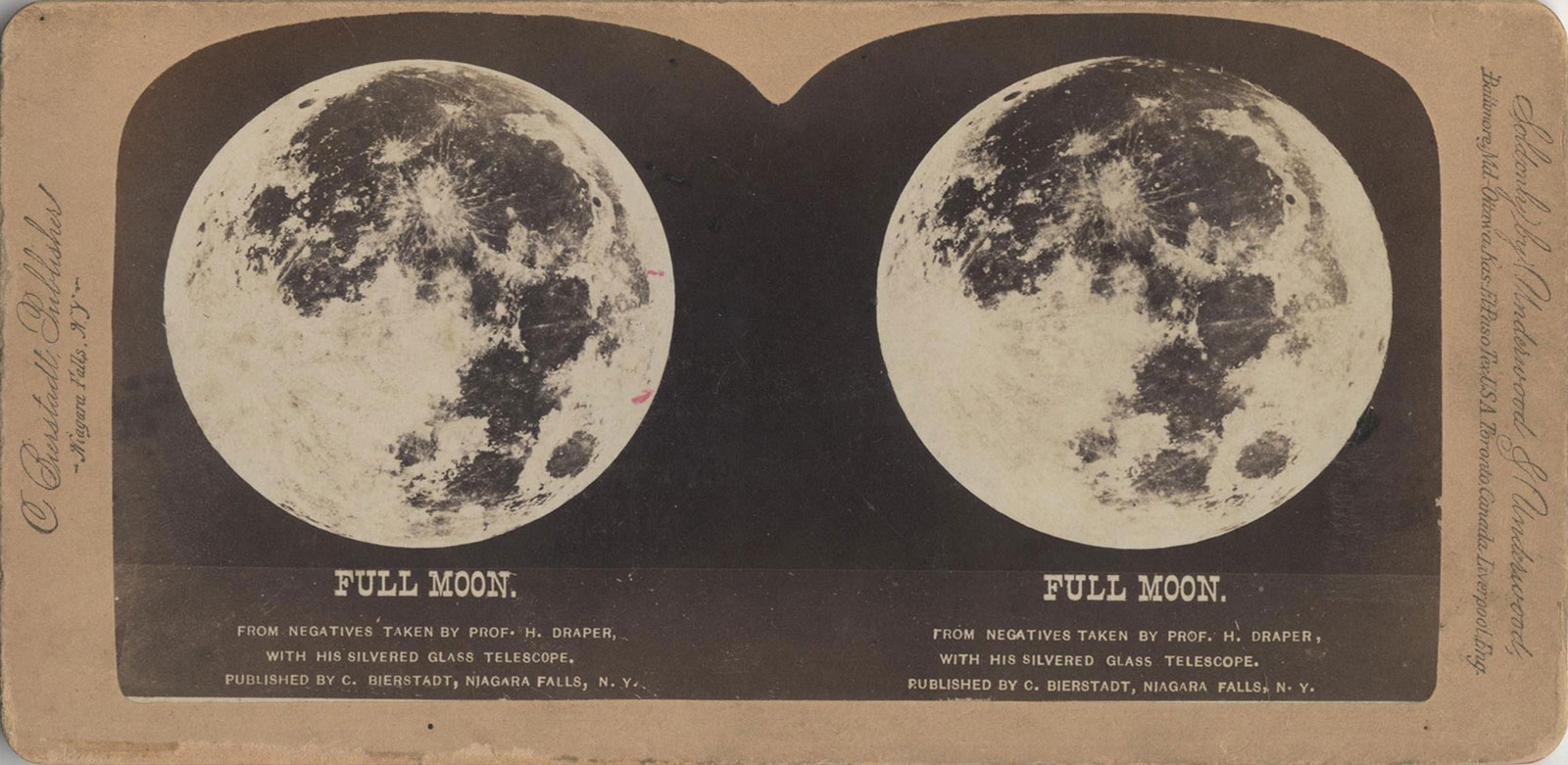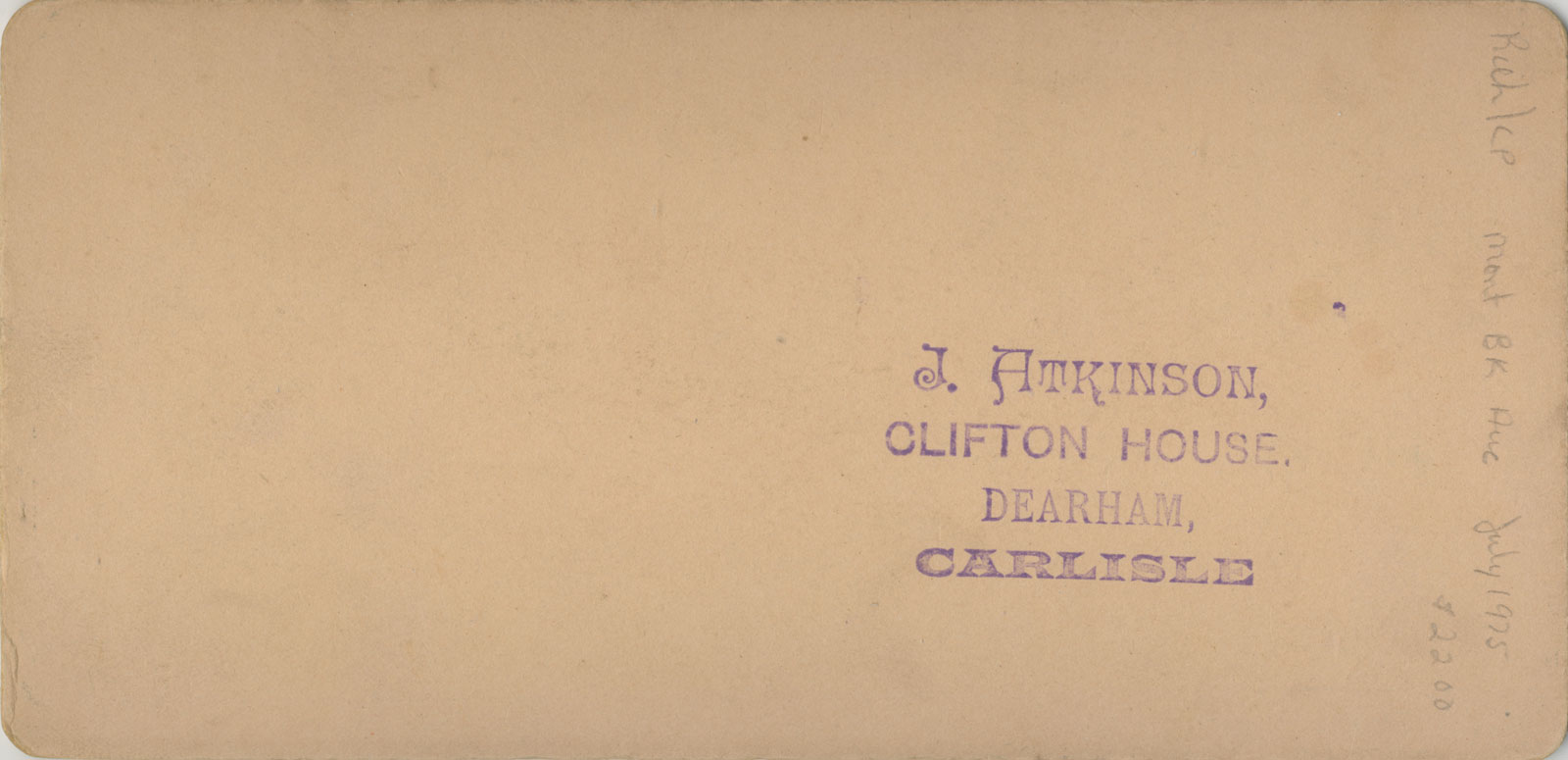Full Moon
Stereophotography, or stereography, takes this realism one step further by providing a three-dimensional image rather than a two-dimensional one. 19th century writer, David Brewster, continually refers to stereography as a more truthful and accurate medium than writing or drawing. He advocates stereography’s application to scientific study and education, arguing “[a teacher] may pour it in by the ear, or extract it from the printed page or exhibit it in caricature…but unless he teaches through the eye…by means of truthful pictures…no satisfactory instruction can be conveyed”(Brewster 195). However, scientists also recognized that this claim is somewhat paradoxical: in order to access “the truth,” one must first, by looking through the stereoscope, manipulate the eyes in order to see it.
The photograph as an absolute, objective record is problematic. Photography in the 19th century appeared to be a relatively passive medium and this concept fed into an assumption of complete objectivity (Wilder 19). But practical concerns such as differences in technique (e.g. emulsions, exposure) and environment (e.g. weather, heat, dryness) prevented the consistently repeatable results so important to scientific method (19-21). Secondly, the photographer’s motivations ultimately determine what is included or excluded from the frame. As photography, and stereography, begin to interact with both scientific and commercial interests, we might also ask how different motivations inform the particular version of “the truth” presented.
Sources and Further Reading:
Brewster, David. The Stereoscope; its history, theory, and construction, with its application to the fine and useful arts and to education. London: Hotten, 1870.
Tucker, Jennifer. Nature Exposed: Photography as Eyewitness in Victorian Science. Baltimore: John Hopkins University Press, 2005. Print.
Wilder, Kelley. Photography and Science. London: Reaktion Books, 2009. Print.
Though we might consider them separate professions today, scientists in the 19th century were often photographers or inventors as well. Henry Draper, who likely took the photographs that make up this stereograph, developed his own telescope with which he took photographs of the moon in the 1860s and 1870s (Barker 92-94). Although his lunar photographs were likely not intended to be stereographs, Draper may have given permission for the publisher, Charles Bierstadt, to use them for commercial purposes like his father, J. W. Draper, once did (Darrah 147). The photographs that make up this stereograph were likely taken hours apart. That way, the Earth’s rotation would carry the telescope and camera far enough away that the two images would show the displacement necessary to the stereograph’s 3D effect (Whiting n.p.).
The relationship between 19th century scientific rhetoric and commercial rhetoric also carries implications for the stereograph’s claims to truthfulness. In New Media, 1740-1915, Schiavo argues that scientific rhetoric recognized that the stereoscope, by manipulating viewers into seeing a 3D image that was not actually there, raised “fundamental questions about the status and reliability of vision” (114-116). But stereo card sellers marketed the stereoscope as a scientific tool that popular audiences could use to comprehend and appreciate human vision and vaguely alluded to science as authority without considering its actual scientific complexities or consequences (Schiavo 125-126). Thus, the layman encountered stereography as a commodified and “faithful image of human perception” (126).
Sources and Further Reading:
Barker, George F. Memoir of Henry Draper 1837-1882. 1888. The National Academy of Sciences. Web. 13 Nov 2014. Available online
Darrah, WIlliam. The World of Stereographs. Gettysburg: William C. Darrah, 1977.
Schiavo, Laura B. “From Phantom Image to Perfect Vision: Physiological Optics, Commercial Photography, and the Popularity of the Stereoscope.”New Media, 1740-1915. ed. Lisa Gitelman and Geoffrey B. Pingree. Cambridge, Massachussetts: MIT Press, 2003. Print.
Wilder, Kelley. Photography and Science. London: Reaktion Books, 2009. Print.
Whiting, Alan. Email correspondence, forwarded by Prof. Scott-Morgan Straker. 16 Jan. 2015.
Thus, this stereograph of the moon can be seen as a way to “travel” to the moon about a hundred years before the lunar landing. This view of the moon, as a stereo card, would have been easily portable, sellable, and consumable. In this way, we—as well as 19th-century users at the time—might see stereography as empowering and a symbol of humanity’s mastery of nature via technology. But such a vision has its costs: Schiavo notes that, through marketing and commodification, stereography loses its roots in scientific inquiry (121-5). Instead, its relation to science was vaguely described and largely exploited as a selling point without any explanation of its scientific process or implications (127).
Furthermore, Crary describes how users themselves become part of the “optical device” since stereoscopy relies on the binocular vision and mental processes of the person looking (131-2). Drawing on Marx, Crary contends that the “machine makes use of man by subjecting him to a relation of contiguity, of parts to otherparts, and of exchangeability” (131). During the rise of the industrial age, Victorian users were both anxious about and fascinated by the increasingly blurred lines between humans, commodities, and machines — an ambivalence that persists in our modern-day computer age.
Sources and Further Reading:
Crary, Jonathan. Techniques of the Observer: On Vision and Modernity in the Nineteenth Century. Cambridge, Mass: MIT Press, 1990. Print.
Marx, Karl. “Economic Manuscripts: Grundrisse: p 501 – p 550.” Marxists Internet Archive. Marxists.org, n.d. Web. 19 Feb. 2015. Available online
Natale, Simone. “Photography and Communication Media in the Nineteenth Century.” History of Photography. 36.4 (2012): 451–456. Web. 20 Feb. 2015.
Schiavo, Laura Burd. “From Phantom Image to Perfect Vision: Physiological Optics, Commercial Photography, and the Popularity of the Stereoscope.”New Media, 1740-1915. ed. Lisa Gitelman and Geoffrey B. Pingree. Cambridge, Massachussetts: MIT Press, 2003. Print.


